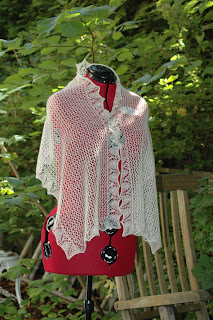In my book project, I plan to show different types of knitted laces. I had already Incorporated both Estonian and Shetland patterns (often in combination); hairy and smooth shawls; with and without nobs. But I had no sheer shawls. A large part of the Shetland tradition with knitted laces is to make almost transparent laces which you may tread through a ring (so-called ring shawls). I just had to make one of these for my book.
I was a bit unsure about the pattern to chose for this shawl. I wanted something stylish and timeless. Often, ring-shawls have elaborate patterns. However, I wanted something simple and airy, in black, as a veil over a nice dress.
After searching my books, I found two patterns in Barara G. Walker's book series ”A treasury of knitting patterns” which may fit such a shawl. The patterns are called "Dainty Chevron" and "Daintier Chevron". It is really just one pattern. The difference between them is that in one, the pattern is knitted on both sides, whereas in the other, a round of plain knitting is included on the purl side.
The centre of the shawl is knitted in two halfs, and then sewn together to make the pattern symmetrical. Then the outer border is knitted on in a traditional Shetland way: where the border is knitted across and attached to the shawl by knitting the last stitch in the border together with the next stitch of the shawl. I chose a simple border from the book "Heirloom Knitting" by Sharon Miller. This pattern is knitted on both sides, which makes it very airy as well.
The centre of the shawl is knitted in two halfs, and then sewn together to make the pattern symmetrical. Then the outer border is knitted on in a traditional Shetland way: where the border is knitted across and attached to the shawl by knitting the last stitch in the border together with the next stitch of the shawl. I chose a simple border from the book "Heirloom Knitting" by Sharon Miller. This pattern is knitted on both sides, which makes it very airy as well.
 I used a very fine charcoal coloured merino wool yarn called "Fine merino", which I bought at "Purl soho". I also used this yarn for My first ring shawl. This yarn gives a very light shawl, and together with the fine lace pattern it made the shawl almost invisible.
I used a very fine charcoal coloured merino wool yarn called "Fine merino", which I bought at "Purl soho". I also used this yarn for My first ring shawl. This yarn gives a very light shawl, and together with the fine lace pattern it made the shawl almost invisible. This is a challenging shawl to knit because of the thin yarn and the very fine lace pattern, but I got the shawl I wanted in the end.














































